Organisational Theory and Practice: A Study of Apple Inc.'s Leadership
VerifiedAdded on 2023/06/04
|12
|3766
|445
Report
AI Summary
This report scrutinizes Apple Inc.'s organisational theories and practices, focusing on the efficacy of the CEO's leadership style, its impact on organisational culture and high-performance standards, and the business strategy and corporate governance policies implemented to enhance structural competence. It further examines the effects of power, influence, and conflict resolution strategies employed by the CEO in managing change, as well as the various motivation tactics used to stimulate employee performance. The analysis covers Tim Cook's democratic leadership approach in contrast to Steve Jobs' autocratic style, the importance of customer experience and vertical integration in Apple's business strategy, and the shift towards prioritizing professional services. The report also addresses conflict management strategies and the importance of stakeholder involvement. The document concludes with recommendations for sustaining Apple's success.
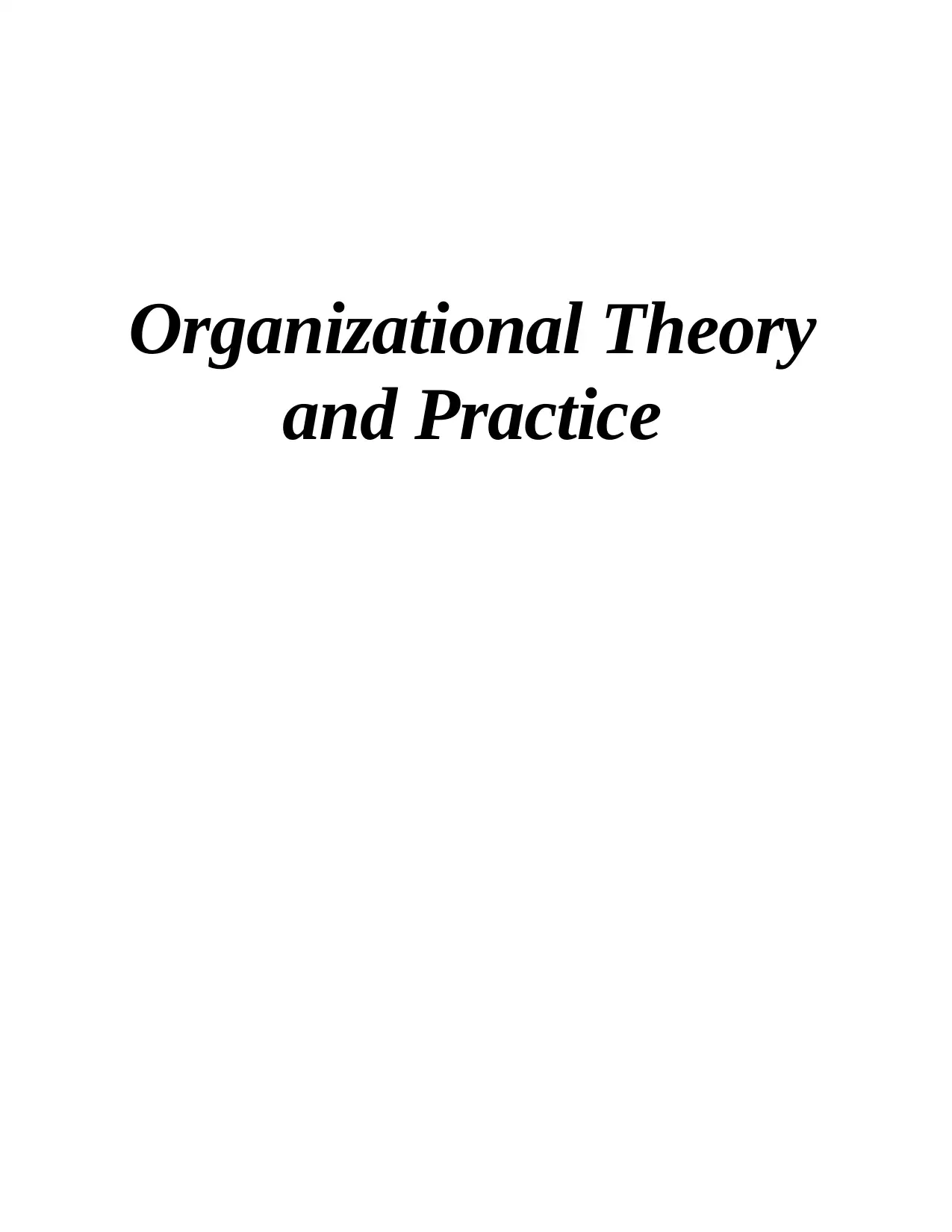
Organizational Theory
and Practice
and Practice
Paraphrase This Document
Need a fresh take? Get an instant paraphrase of this document with our AI Paraphraser
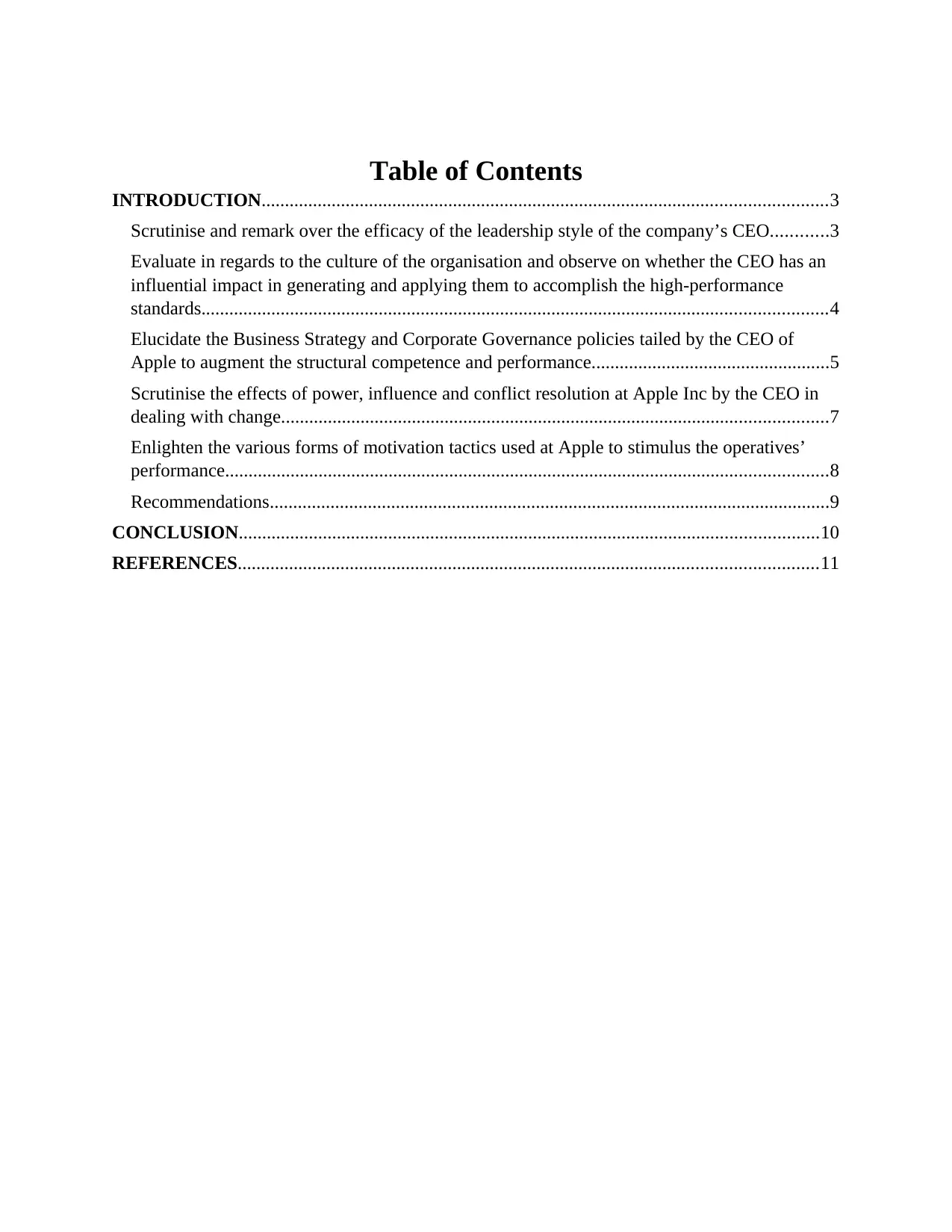
Table of Contents
INTRODUCTION.........................................................................................................................3
Scrutinise and remark over the efficacy of the leadership style of the company’s CEO............3
Evaluate in regards to the culture of the organisation and observe on whether the CEO has an
influential impact in generating and applying them to accomplish the high-performance
standards......................................................................................................................................4
Elucidate the Business Strategy and Corporate Governance policies tailed by the CEO of
Apple to augment the structural competence and performance...................................................5
Scrutinise the effects of power, influence and conflict resolution at Apple Inc by the CEO in
dealing with change.....................................................................................................................7
Enlighten the various forms of motivation tactics used at Apple to stimulus the operatives’
performance.................................................................................................................................8
Recommendations........................................................................................................................9
CONCLUSION............................................................................................................................10
REFERENCES............................................................................................................................11
INTRODUCTION.........................................................................................................................3
Scrutinise and remark over the efficacy of the leadership style of the company’s CEO............3
Evaluate in regards to the culture of the organisation and observe on whether the CEO has an
influential impact in generating and applying them to accomplish the high-performance
standards......................................................................................................................................4
Elucidate the Business Strategy and Corporate Governance policies tailed by the CEO of
Apple to augment the structural competence and performance...................................................5
Scrutinise the effects of power, influence and conflict resolution at Apple Inc by the CEO in
dealing with change.....................................................................................................................7
Enlighten the various forms of motivation tactics used at Apple to stimulus the operatives’
performance.................................................................................................................................8
Recommendations........................................................................................................................9
CONCLUSION............................................................................................................................10
REFERENCES............................................................................................................................11
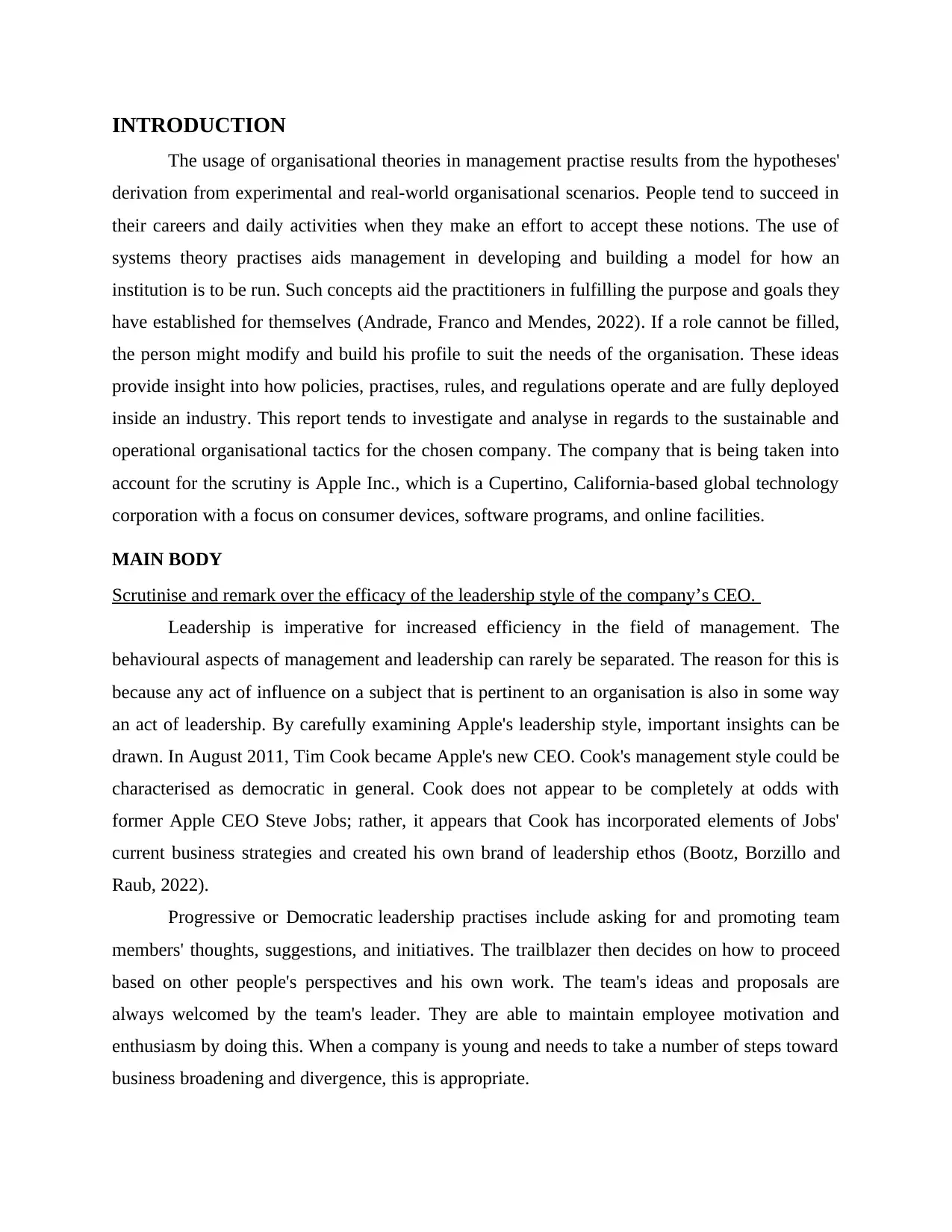
INTRODUCTION
The usage of organisational theories in management practise results from the hypotheses'
derivation from experimental and real-world organisational scenarios. People tend to succeed in
their careers and daily activities when they make an effort to accept these notions. The use of
systems theory practises aids management in developing and building a model for how an
institution is to be run. Such concepts aid the practitioners in fulfilling the purpose and goals they
have established for themselves (Andrade, Franco and Mendes, 2022). If a role cannot be filled,
the person might modify and build his profile to suit the needs of the organisation. These ideas
provide insight into how policies, practises, rules, and regulations operate and are fully deployed
inside an industry. This report tends to investigate and analyse in regards to the sustainable and
operational organisational tactics for the chosen company. The company that is being taken into
account for the scrutiny is Apple Inc., which is a Cupertino, California-based global technology
corporation with a focus on consumer devices, software programs, and online facilities.
MAIN BODY
Scrutinise and remark over the efficacy of the leadership style of the company’s CEO.
Leadership is imperative for increased efficiency in the field of management. The
behavioural aspects of management and leadership can rarely be separated. The reason for this is
because any act of influence on a subject that is pertinent to an organisation is also in some way
an act of leadership. By carefully examining Apple's leadership style, important insights can be
drawn. In August 2011, Tim Cook became Apple's new CEO. Cook's management style could be
characterised as democratic in general. Cook does not appear to be completely at odds with
former Apple CEO Steve Jobs; rather, it appears that Cook has incorporated elements of Jobs'
current business strategies and created his own brand of leadership ethos (Bootz, Borzillo and
Raub, 2022).
Progressive or Democratic leadership practises include asking for and promoting team
members' thoughts, suggestions, and initiatives. The trailblazer then decides on how to proceed
based on other people's perspectives and his own work. The team's ideas and proposals are
always welcomed by the team's leader. They are able to maintain employee motivation and
enthusiasm by doing this. When a company is young and needs to take a number of steps toward
business broadening and divergence, this is appropriate.
The usage of organisational theories in management practise results from the hypotheses'
derivation from experimental and real-world organisational scenarios. People tend to succeed in
their careers and daily activities when they make an effort to accept these notions. The use of
systems theory practises aids management in developing and building a model for how an
institution is to be run. Such concepts aid the practitioners in fulfilling the purpose and goals they
have established for themselves (Andrade, Franco and Mendes, 2022). If a role cannot be filled,
the person might modify and build his profile to suit the needs of the organisation. These ideas
provide insight into how policies, practises, rules, and regulations operate and are fully deployed
inside an industry. This report tends to investigate and analyse in regards to the sustainable and
operational organisational tactics for the chosen company. The company that is being taken into
account for the scrutiny is Apple Inc., which is a Cupertino, California-based global technology
corporation with a focus on consumer devices, software programs, and online facilities.
MAIN BODY
Scrutinise and remark over the efficacy of the leadership style of the company’s CEO.
Leadership is imperative for increased efficiency in the field of management. The
behavioural aspects of management and leadership can rarely be separated. The reason for this is
because any act of influence on a subject that is pertinent to an organisation is also in some way
an act of leadership. By carefully examining Apple's leadership style, important insights can be
drawn. In August 2011, Tim Cook became Apple's new CEO. Cook's management style could be
characterised as democratic in general. Cook does not appear to be completely at odds with
former Apple CEO Steve Jobs; rather, it appears that Cook has incorporated elements of Jobs'
current business strategies and created his own brand of leadership ethos (Bootz, Borzillo and
Raub, 2022).
Progressive or Democratic leadership practises include asking for and promoting team
members' thoughts, suggestions, and initiatives. The trailblazer then decides on how to proceed
based on other people's perspectives and his own work. The team's ideas and proposals are
always welcomed by the team's leader. They are able to maintain employee motivation and
enthusiasm by doing this. When a company is young and needs to take a number of steps toward
business broadening and divergence, this is appropriate.
⊘ This is a preview!⊘
Do you want full access?
Subscribe today to unlock all pages.

Trusted by 1+ million students worldwide
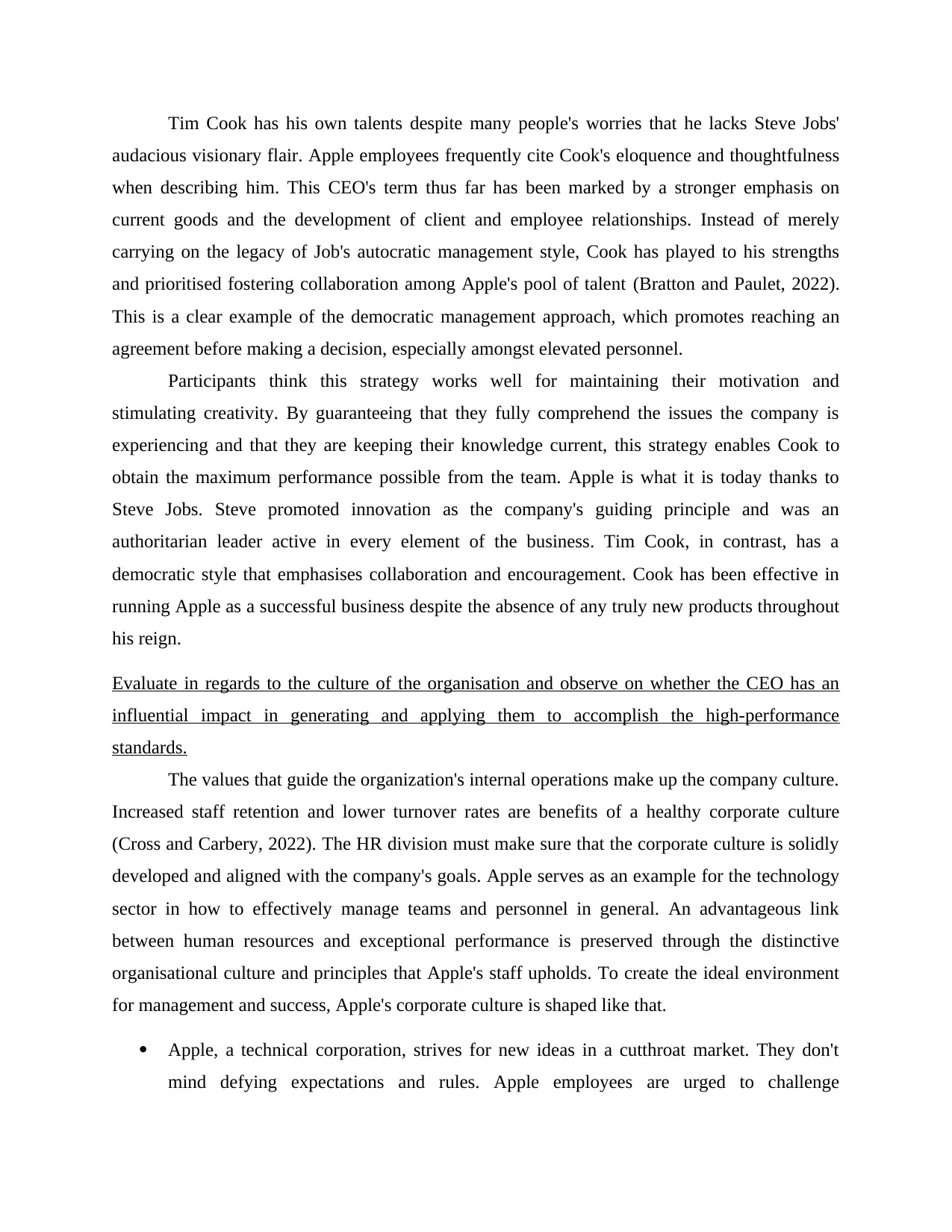
Tim Cook has his own talents despite many people's worries that he lacks Steve Jobs'
audacious visionary flair. Apple employees frequently cite Cook's eloquence and thoughtfulness
when describing him. This CEO's term thus far has been marked by a stronger emphasis on
current goods and the development of client and employee relationships. Instead of merely
carrying on the legacy of Job's autocratic management style, Cook has played to his strengths
and prioritised fostering collaboration among Apple's pool of talent (Bratton and Paulet, 2022).
This is a clear example of the democratic management approach, which promotes reaching an
agreement before making a decision, especially amongst elevated personnel.
Participants think this strategy works well for maintaining their motivation and
stimulating creativity. By guaranteeing that they fully comprehend the issues the company is
experiencing and that they are keeping their knowledge current, this strategy enables Cook to
obtain the maximum performance possible from the team. Apple is what it is today thanks to
Steve Jobs. Steve promoted innovation as the company's guiding principle and was an
authoritarian leader active in every element of the business. Tim Cook, in contrast, has a
democratic style that emphasises collaboration and encouragement. Cook has been effective in
running Apple as a successful business despite the absence of any truly new products throughout
his reign.
Evaluate in regards to the culture of the organisation and observe on whether the CEO has an
influential impact in generating and applying them to accomplish the high-performance
standards.
The values that guide the organization's internal operations make up the company culture.
Increased staff retention and lower turnover rates are benefits of a healthy corporate culture
(Cross and Carbery, 2022). The HR division must make sure that the corporate culture is solidly
developed and aligned with the company's goals. Apple serves as an example for the technology
sector in how to effectively manage teams and personnel in general. An advantageous link
between human resources and exceptional performance is preserved through the distinctive
organisational culture and principles that Apple's staff upholds. To create the ideal environment
for management and success, Apple's corporate culture is shaped like that.
Apple, a technical corporation, strives for new ideas in a cutthroat market. They don't
mind defying expectations and rules. Apple employees are urged to challenge
audacious visionary flair. Apple employees frequently cite Cook's eloquence and thoughtfulness
when describing him. This CEO's term thus far has been marked by a stronger emphasis on
current goods and the development of client and employee relationships. Instead of merely
carrying on the legacy of Job's autocratic management style, Cook has played to his strengths
and prioritised fostering collaboration among Apple's pool of talent (Bratton and Paulet, 2022).
This is a clear example of the democratic management approach, which promotes reaching an
agreement before making a decision, especially amongst elevated personnel.
Participants think this strategy works well for maintaining their motivation and
stimulating creativity. By guaranteeing that they fully comprehend the issues the company is
experiencing and that they are keeping their knowledge current, this strategy enables Cook to
obtain the maximum performance possible from the team. Apple is what it is today thanks to
Steve Jobs. Steve promoted innovation as the company's guiding principle and was an
authoritarian leader active in every element of the business. Tim Cook, in contrast, has a
democratic style that emphasises collaboration and encouragement. Cook has been effective in
running Apple as a successful business despite the absence of any truly new products throughout
his reign.
Evaluate in regards to the culture of the organisation and observe on whether the CEO has an
influential impact in generating and applying them to accomplish the high-performance
standards.
The values that guide the organization's internal operations make up the company culture.
Increased staff retention and lower turnover rates are benefits of a healthy corporate culture
(Cross and Carbery, 2022). The HR division must make sure that the corporate culture is solidly
developed and aligned with the company's goals. Apple serves as an example for the technology
sector in how to effectively manage teams and personnel in general. An advantageous link
between human resources and exceptional performance is preserved through the distinctive
organisational culture and principles that Apple's staff upholds. To create the ideal environment
for management and success, Apple's corporate culture is shaped like that.
Apple, a technical corporation, strives for new ideas in a cutthroat market. They don't
mind defying expectations and rules. Apple employees are urged to challenge
Paraphrase This Document
Need a fresh take? Get an instant paraphrase of this document with our AI Paraphraser
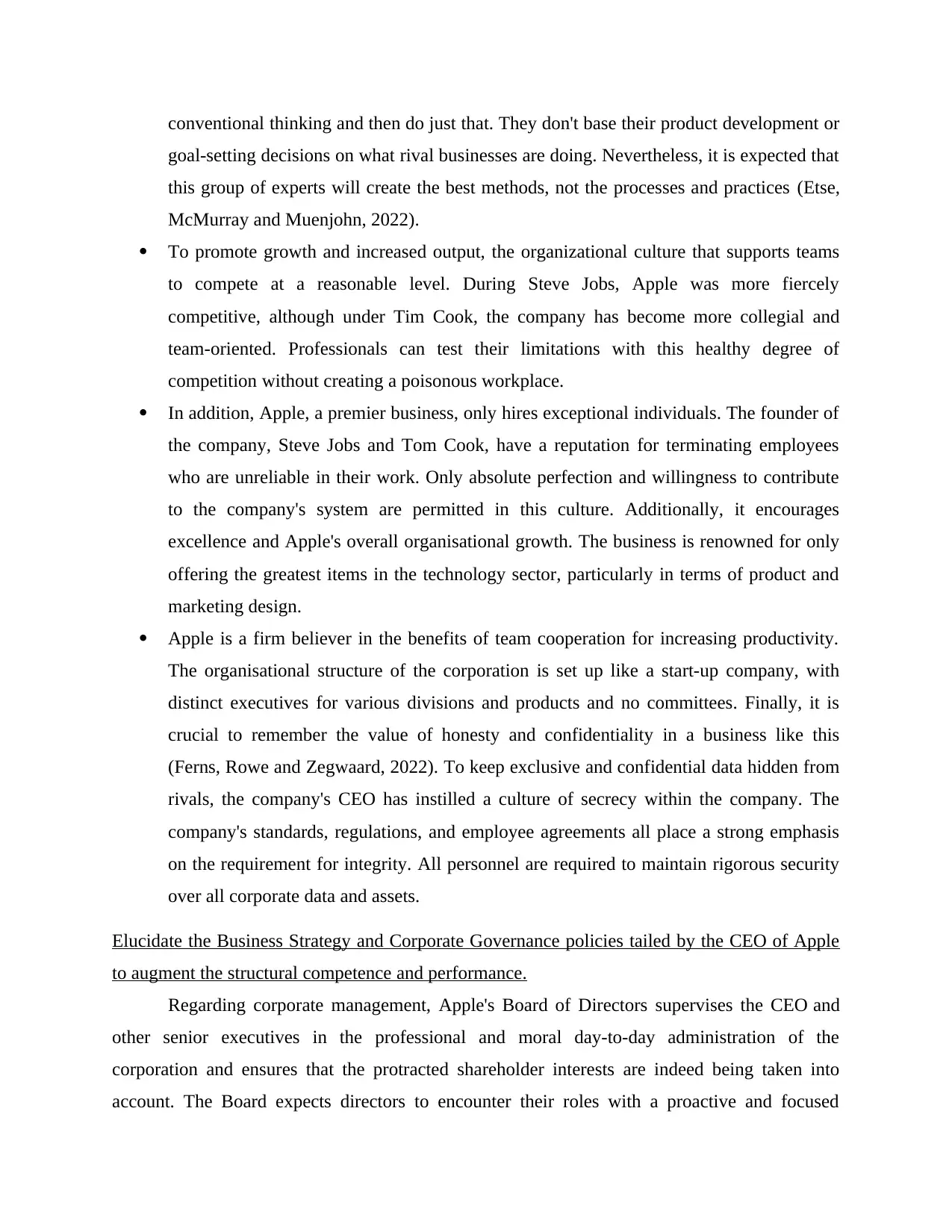
conventional thinking and then do just that. They don't base their product development or
goal-setting decisions on what rival businesses are doing. Nevertheless, it is expected that
this group of experts will create the best methods, not the processes and practices (Etse,
McMurray and Muenjohn, 2022).
To promote growth and increased output, the organizational culture that supports teams
to compete at a reasonable level. During Steve Jobs, Apple was more fiercely
competitive, although under Tim Cook, the company has become more collegial and
team-oriented. Professionals can test their limitations with this healthy degree of
competition without creating a poisonous workplace.
In addition, Apple, a premier business, only hires exceptional individuals. The founder of
the company, Steve Jobs and Tom Cook, have a reputation for terminating employees
who are unreliable in their work. Only absolute perfection and willingness to contribute
to the company's system are permitted in this culture. Additionally, it encourages
excellence and Apple's overall organisational growth. The business is renowned for only
offering the greatest items in the technology sector, particularly in terms of product and
marketing design.
Apple is a firm believer in the benefits of team cooperation for increasing productivity.
The organisational structure of the corporation is set up like a start-up company, with
distinct executives for various divisions and products and no committees. Finally, it is
crucial to remember the value of honesty and confidentiality in a business like this
(Ferns, Rowe and Zegwaard, 2022). To keep exclusive and confidential data hidden from
rivals, the company's CEO has instilled a culture of secrecy within the company. The
company's standards, regulations, and employee agreements all place a strong emphasis
on the requirement for integrity. All personnel are required to maintain rigorous security
over all corporate data and assets.
Elucidate the Business Strategy and Corporate Governance policies tailed by the CEO of Apple
to augment the structural competence and performance.
Regarding corporate management, Apple's Board of Directors supervises the CEO and
other senior executives in the professional and moral day-to-day administration of the
corporation and ensures that the protracted shareholder interests are indeed being taken into
account. The Board expects directors to encounter their roles with a proactive and focused
goal-setting decisions on what rival businesses are doing. Nevertheless, it is expected that
this group of experts will create the best methods, not the processes and practices (Etse,
McMurray and Muenjohn, 2022).
To promote growth and increased output, the organizational culture that supports teams
to compete at a reasonable level. During Steve Jobs, Apple was more fiercely
competitive, although under Tim Cook, the company has become more collegial and
team-oriented. Professionals can test their limitations with this healthy degree of
competition without creating a poisonous workplace.
In addition, Apple, a premier business, only hires exceptional individuals. The founder of
the company, Steve Jobs and Tom Cook, have a reputation for terminating employees
who are unreliable in their work. Only absolute perfection and willingness to contribute
to the company's system are permitted in this culture. Additionally, it encourages
excellence and Apple's overall organisational growth. The business is renowned for only
offering the greatest items in the technology sector, particularly in terms of product and
marketing design.
Apple is a firm believer in the benefits of team cooperation for increasing productivity.
The organisational structure of the corporation is set up like a start-up company, with
distinct executives for various divisions and products and no committees. Finally, it is
crucial to remember the value of honesty and confidentiality in a business like this
(Ferns, Rowe and Zegwaard, 2022). To keep exclusive and confidential data hidden from
rivals, the company's CEO has instilled a culture of secrecy within the company. The
company's standards, regulations, and employee agreements all place a strong emphasis
on the requirement for integrity. All personnel are required to maintain rigorous security
over all corporate data and assets.
Elucidate the Business Strategy and Corporate Governance policies tailed by the CEO of Apple
to augment the structural competence and performance.
Regarding corporate management, Apple's Board of Directors supervises the CEO and
other senior executives in the professional and moral day-to-day administration of the
corporation and ensures that the protracted shareholder interests are indeed being taken into
account. The Board expects directors to encounter their roles with a proactive and focused
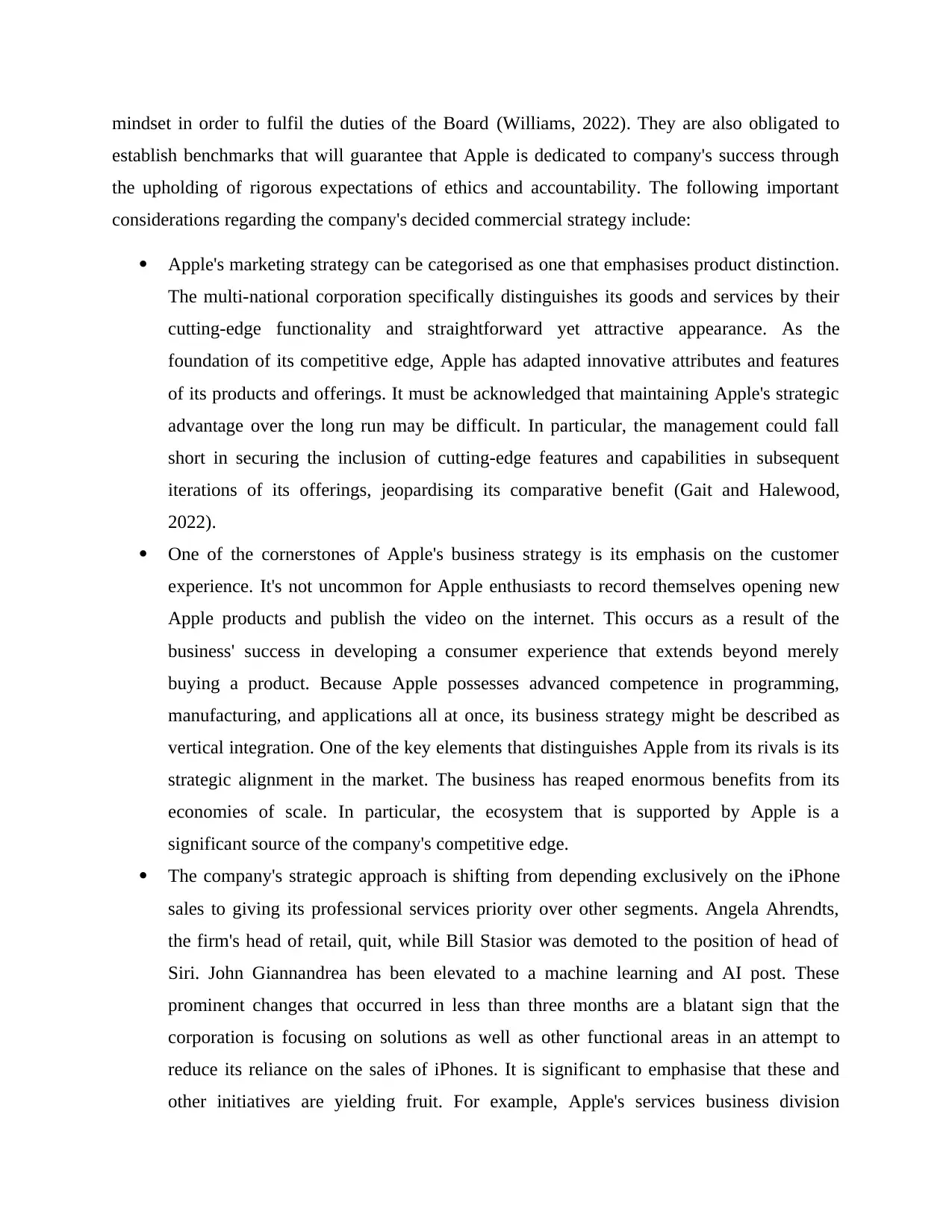
mindset in order to fulfil the duties of the Board (Williams, 2022). They are also obligated to
establish benchmarks that will guarantee that Apple is dedicated to company's success through
the upholding of rigorous expectations of ethics and accountability. The following important
considerations regarding the company's decided commercial strategy include:
Apple's marketing strategy can be categorised as one that emphasises product distinction.
The multi-national corporation specifically distinguishes its goods and services by their
cutting-edge functionality and straightforward yet attractive appearance. As the
foundation of its competitive edge, Apple has adapted innovative attributes and features
of its products and offerings. It must be acknowledged that maintaining Apple's strategic
advantage over the long run may be difficult. In particular, the management could fall
short in securing the inclusion of cutting-edge features and capabilities in subsequent
iterations of its offerings, jeopardising its comparative benefit (Gait and Halewood,
2022).
One of the cornerstones of Apple's business strategy is its emphasis on the customer
experience. It's not uncommon for Apple enthusiasts to record themselves opening new
Apple products and publish the video on the internet. This occurs as a result of the
business' success in developing a consumer experience that extends beyond merely
buying a product. Because Apple possesses advanced competence in programming,
manufacturing, and applications all at once, its business strategy might be described as
vertical integration. One of the key elements that distinguishes Apple from its rivals is its
strategic alignment in the market. The business has reaped enormous benefits from its
economies of scale. In particular, the ecosystem that is supported by Apple is a
significant source of the company's competitive edge.
The company's strategic approach is shifting from depending exclusively on the iPhone
sales to giving its professional services priority over other segments. Angela Ahrendts,
the firm's head of retail, quit, while Bill Stasior was demoted to the position of head of
Siri. John Giannandrea has been elevated to a machine learning and AI post. These
prominent changes that occurred in less than three months are a blatant sign that the
corporation is focusing on solutions as well as other functional areas in an attempt to
reduce its reliance on the sales of iPhones. It is significant to emphasise that these and
other initiatives are yielding fruit. For example, Apple's services business division
establish benchmarks that will guarantee that Apple is dedicated to company's success through
the upholding of rigorous expectations of ethics and accountability. The following important
considerations regarding the company's decided commercial strategy include:
Apple's marketing strategy can be categorised as one that emphasises product distinction.
The multi-national corporation specifically distinguishes its goods and services by their
cutting-edge functionality and straightforward yet attractive appearance. As the
foundation of its competitive edge, Apple has adapted innovative attributes and features
of its products and offerings. It must be acknowledged that maintaining Apple's strategic
advantage over the long run may be difficult. In particular, the management could fall
short in securing the inclusion of cutting-edge features and capabilities in subsequent
iterations of its offerings, jeopardising its comparative benefit (Gait and Halewood,
2022).
One of the cornerstones of Apple's business strategy is its emphasis on the customer
experience. It's not uncommon for Apple enthusiasts to record themselves opening new
Apple products and publish the video on the internet. This occurs as a result of the
business' success in developing a consumer experience that extends beyond merely
buying a product. Because Apple possesses advanced competence in programming,
manufacturing, and applications all at once, its business strategy might be described as
vertical integration. One of the key elements that distinguishes Apple from its rivals is its
strategic alignment in the market. The business has reaped enormous benefits from its
economies of scale. In particular, the ecosystem that is supported by Apple is a
significant source of the company's competitive edge.
The company's strategic approach is shifting from depending exclusively on the iPhone
sales to giving its professional services priority over other segments. Angela Ahrendts,
the firm's head of retail, quit, while Bill Stasior was demoted to the position of head of
Siri. John Giannandrea has been elevated to a machine learning and AI post. These
prominent changes that occurred in less than three months are a blatant sign that the
corporation is focusing on solutions as well as other functional areas in an attempt to
reduce its reliance on the sales of iPhones. It is significant to emphasise that these and
other initiatives are yielding fruit. For example, Apple's services business division
⊘ This is a preview!⊘
Do you want full access?
Subscribe today to unlock all pages.

Trusted by 1+ million students worldwide
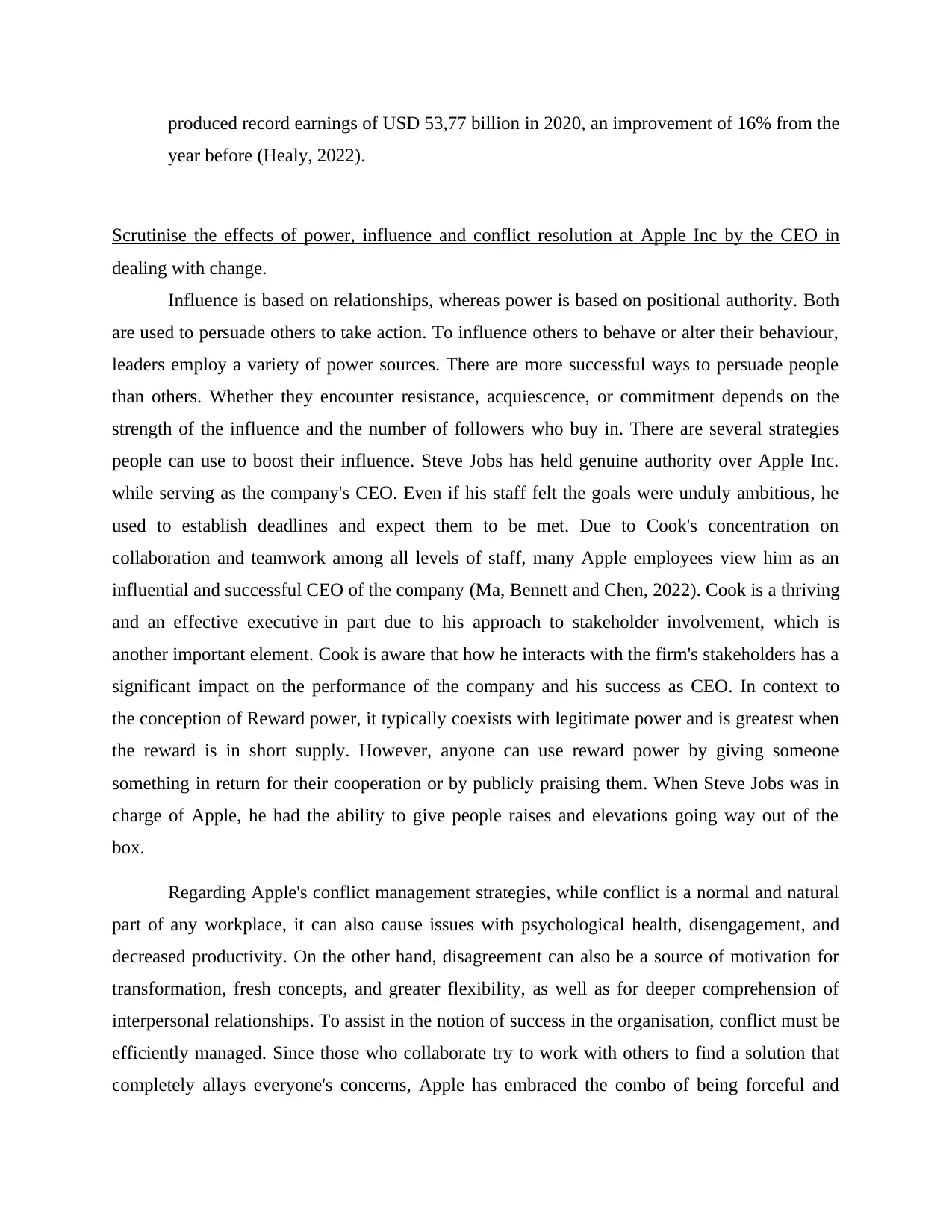
produced record earnings of USD 53,77 billion in 2020, an improvement of 16% from the
year before (Healy, 2022).
Scrutinise the effects of power, influence and conflict resolution at Apple Inc by the CEO in
dealing with change.
Influence is based on relationships, whereas power is based on positional authority. Both
are used to persuade others to take action. To influence others to behave or alter their behaviour,
leaders employ a variety of power sources. There are more successful ways to persuade people
than others. Whether they encounter resistance, acquiescence, or commitment depends on the
strength of the influence and the number of followers who buy in. There are several strategies
people can use to boost their influence. Steve Jobs has held genuine authority over Apple Inc.
while serving as the company's CEO. Even if his staff felt the goals were unduly ambitious, he
used to establish deadlines and expect them to be met. Due to Cook's concentration on
collaboration and teamwork among all levels of staff, many Apple employees view him as an
influential and successful CEO of the company (Ma, Bennett and Chen, 2022). Cook is a thriving
and an effective executive in part due to his approach to stakeholder involvement, which is
another important element. Cook is aware that how he interacts with the firm's stakeholders has a
significant impact on the performance of the company and his success as CEO. In context to
the conception of Reward power, it typically coexists with legitimate power and is greatest when
the reward is in short supply. However, anyone can use reward power by giving someone
something in return for their cooperation or by publicly praising them. When Steve Jobs was in
charge of Apple, he had the ability to give people raises and elevations going way out of the
box.
Regarding Apple's conflict management strategies, while conflict is a normal and natural
part of any workplace, it can also cause issues with psychological health, disengagement, and
decreased productivity. On the other hand, disagreement can also be a source of motivation for
transformation, fresh concepts, and greater flexibility, as well as for deeper comprehension of
interpersonal relationships. To assist in the notion of success in the organisation, conflict must be
efficiently managed. Since those who collaborate try to work with others to find a solution that
completely allays everyone's concerns, Apple has embraced the combo of being forceful and
year before (Healy, 2022).
Scrutinise the effects of power, influence and conflict resolution at Apple Inc by the CEO in
dealing with change.
Influence is based on relationships, whereas power is based on positional authority. Both
are used to persuade others to take action. To influence others to behave or alter their behaviour,
leaders employ a variety of power sources. There are more successful ways to persuade people
than others. Whether they encounter resistance, acquiescence, or commitment depends on the
strength of the influence and the number of followers who buy in. There are several strategies
people can use to boost their influence. Steve Jobs has held genuine authority over Apple Inc.
while serving as the company's CEO. Even if his staff felt the goals were unduly ambitious, he
used to establish deadlines and expect them to be met. Due to Cook's concentration on
collaboration and teamwork among all levels of staff, many Apple employees view him as an
influential and successful CEO of the company (Ma, Bennett and Chen, 2022). Cook is a thriving
and an effective executive in part due to his approach to stakeholder involvement, which is
another important element. Cook is aware that how he interacts with the firm's stakeholders has a
significant impact on the performance of the company and his success as CEO. In context to
the conception of Reward power, it typically coexists with legitimate power and is greatest when
the reward is in short supply. However, anyone can use reward power by giving someone
something in return for their cooperation or by publicly praising them. When Steve Jobs was in
charge of Apple, he had the ability to give people raises and elevations going way out of the
box.
Regarding Apple's conflict management strategies, while conflict is a normal and natural
part of any workplace, it can also cause issues with psychological health, disengagement, and
decreased productivity. On the other hand, disagreement can also be a source of motivation for
transformation, fresh concepts, and greater flexibility, as well as for deeper comprehension of
interpersonal relationships. To assist in the notion of success in the organisation, conflict must be
efficiently managed. Since those who collaborate try to work with others to find a solution that
completely allays everyone's concerns, Apple has embraced the combo of being forceful and
Paraphrase This Document
Need a fresh take? Get an instant paraphrase of this document with our AI Paraphraser
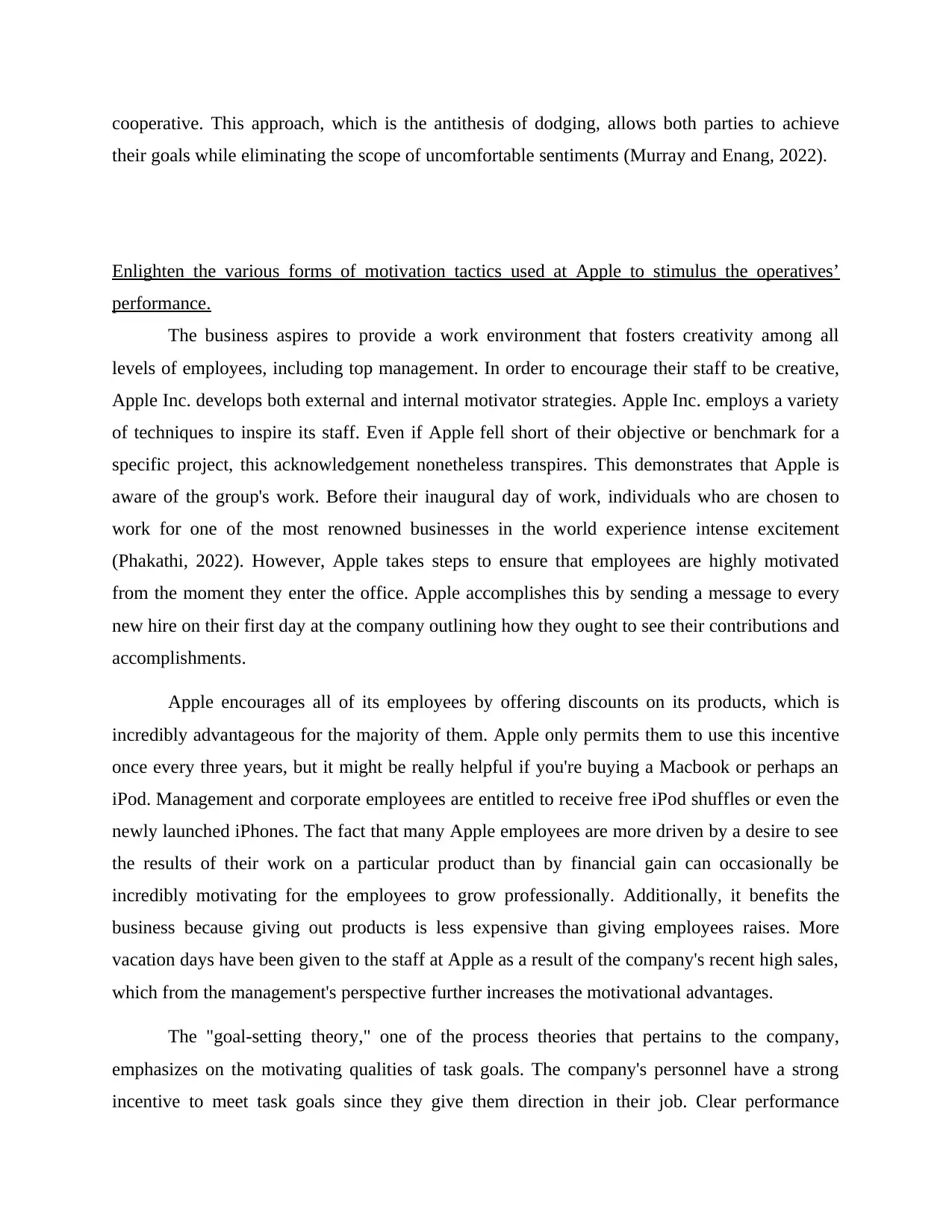
cooperative. This approach, which is the antithesis of dodging, allows both parties to achieve
their goals while eliminating the scope of uncomfortable sentiments (Murray and Enang, 2022).
Enlighten the various forms of motivation tactics used at Apple to stimulus the operatives’
performance.
The business aspires to provide a work environment that fosters creativity among all
levels of employees, including top management. In order to encourage their staff to be creative,
Apple Inc. develops both external and internal motivator strategies. Apple Inc. employs a variety
of techniques to inspire its staff. Even if Apple fell short of their objective or benchmark for a
specific project, this acknowledgement nonetheless transpires. This demonstrates that Apple is
aware of the group's work. Before their inaugural day of work, individuals who are chosen to
work for one of the most renowned businesses in the world experience intense excitement
(Phakathi, 2022). However, Apple takes steps to ensure that employees are highly motivated
from the moment they enter the office. Apple accomplishes this by sending a message to every
new hire on their first day at the company outlining how they ought to see their contributions and
accomplishments.
Apple encourages all of its employees by offering discounts on its products, which is
incredibly advantageous for the majority of them. Apple only permits them to use this incentive
once every three years, but it might be really helpful if you're buying a Macbook or perhaps an
iPod. Management and corporate employees are entitled to receive free iPod shuffles or even the
newly launched iPhones. The fact that many Apple employees are more driven by a desire to see
the results of their work on a particular product than by financial gain can occasionally be
incredibly motivating for the employees to grow professionally. Additionally, it benefits the
business because giving out products is less expensive than giving employees raises. More
vacation days have been given to the staff at Apple as a result of the company's recent high sales,
which from the management's perspective further increases the motivational advantages.
The "goal-setting theory," one of the process theories that pertains to the company,
emphasizes on the motivating qualities of task goals. The company's personnel have a strong
incentive to meet task goals since they give them direction in their job. Clear performance
their goals while eliminating the scope of uncomfortable sentiments (Murray and Enang, 2022).
Enlighten the various forms of motivation tactics used at Apple to stimulus the operatives’
performance.
The business aspires to provide a work environment that fosters creativity among all
levels of employees, including top management. In order to encourage their staff to be creative,
Apple Inc. develops both external and internal motivator strategies. Apple Inc. employs a variety
of techniques to inspire its staff. Even if Apple fell short of their objective or benchmark for a
specific project, this acknowledgement nonetheless transpires. This demonstrates that Apple is
aware of the group's work. Before their inaugural day of work, individuals who are chosen to
work for one of the most renowned businesses in the world experience intense excitement
(Phakathi, 2022). However, Apple takes steps to ensure that employees are highly motivated
from the moment they enter the office. Apple accomplishes this by sending a message to every
new hire on their first day at the company outlining how they ought to see their contributions and
accomplishments.
Apple encourages all of its employees by offering discounts on its products, which is
incredibly advantageous for the majority of them. Apple only permits them to use this incentive
once every three years, but it might be really helpful if you're buying a Macbook or perhaps an
iPod. Management and corporate employees are entitled to receive free iPod shuffles or even the
newly launched iPhones. The fact that many Apple employees are more driven by a desire to see
the results of their work on a particular product than by financial gain can occasionally be
incredibly motivating for the employees to grow professionally. Additionally, it benefits the
business because giving out products is less expensive than giving employees raises. More
vacation days have been given to the staff at Apple as a result of the company's recent high sales,
which from the management's perspective further increases the motivational advantages.
The "goal-setting theory," one of the process theories that pertains to the company,
emphasizes on the motivating qualities of task goals. The company's personnel have a strong
incentive to meet task goals since they give them direction in their job. Clear performance
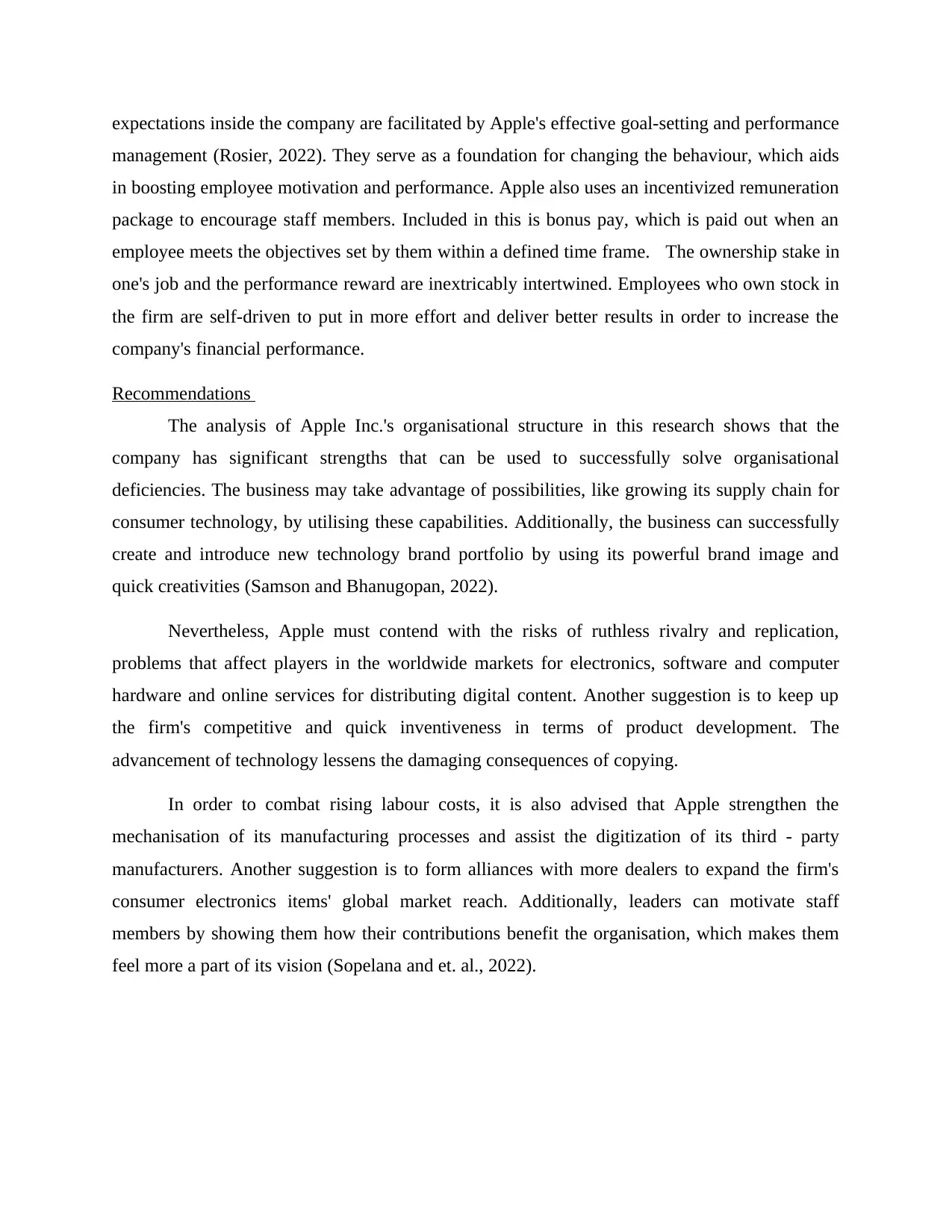
expectations inside the company are facilitated by Apple's effective goal-setting and performance
management (Rosier, 2022). They serve as a foundation for changing the behaviour, which aids
in boosting employee motivation and performance. Apple also uses an incentivized remuneration
package to encourage staff members. Included in this is bonus pay, which is paid out when an
employee meets the objectives set by them within a defined time frame. The ownership stake in
one's job and the performance reward are inextricably intertwined. Employees who own stock in
the firm are self-driven to put in more effort and deliver better results in order to increase the
company's financial performance.
Recommendations
The analysis of Apple Inc.'s organisational structure in this research shows that the
company has significant strengths that can be used to successfully solve organisational
deficiencies. The business may take advantage of possibilities, like growing its supply chain for
consumer technology, by utilising these capabilities. Additionally, the business can successfully
create and introduce new technology brand portfolio by using its powerful brand image and
quick creativities (Samson and Bhanugopan, 2022).
Nevertheless, Apple must contend with the risks of ruthless rivalry and replication,
problems that affect players in the worldwide markets for electronics, software and computer
hardware and online services for distributing digital content. Another suggestion is to keep up
the firm's competitive and quick inventiveness in terms of product development. The
advancement of technology lessens the damaging consequences of copying.
In order to combat rising labour costs, it is also advised that Apple strengthen the
mechanisation of its manufacturing processes and assist the digitization of its third - party
manufacturers. Another suggestion is to form alliances with more dealers to expand the firm's
consumer electronics items' global market reach. Additionally, leaders can motivate staff
members by showing them how their contributions benefit the organisation, which makes them
feel more a part of its vision (Sopelana and et. al., 2022).
management (Rosier, 2022). They serve as a foundation for changing the behaviour, which aids
in boosting employee motivation and performance. Apple also uses an incentivized remuneration
package to encourage staff members. Included in this is bonus pay, which is paid out when an
employee meets the objectives set by them within a defined time frame. The ownership stake in
one's job and the performance reward are inextricably intertwined. Employees who own stock in
the firm are self-driven to put in more effort and deliver better results in order to increase the
company's financial performance.
Recommendations
The analysis of Apple Inc.'s organisational structure in this research shows that the
company has significant strengths that can be used to successfully solve organisational
deficiencies. The business may take advantage of possibilities, like growing its supply chain for
consumer technology, by utilising these capabilities. Additionally, the business can successfully
create and introduce new technology brand portfolio by using its powerful brand image and
quick creativities (Samson and Bhanugopan, 2022).
Nevertheless, Apple must contend with the risks of ruthless rivalry and replication,
problems that affect players in the worldwide markets for electronics, software and computer
hardware and online services for distributing digital content. Another suggestion is to keep up
the firm's competitive and quick inventiveness in terms of product development. The
advancement of technology lessens the damaging consequences of copying.
In order to combat rising labour costs, it is also advised that Apple strengthen the
mechanisation of its manufacturing processes and assist the digitization of its third - party
manufacturers. Another suggestion is to form alliances with more dealers to expand the firm's
consumer electronics items' global market reach. Additionally, leaders can motivate staff
members by showing them how their contributions benefit the organisation, which makes them
feel more a part of its vision (Sopelana and et. al., 2022).
⊘ This is a preview!⊘
Do you want full access?
Subscribe today to unlock all pages.

Trusted by 1+ million students worldwide
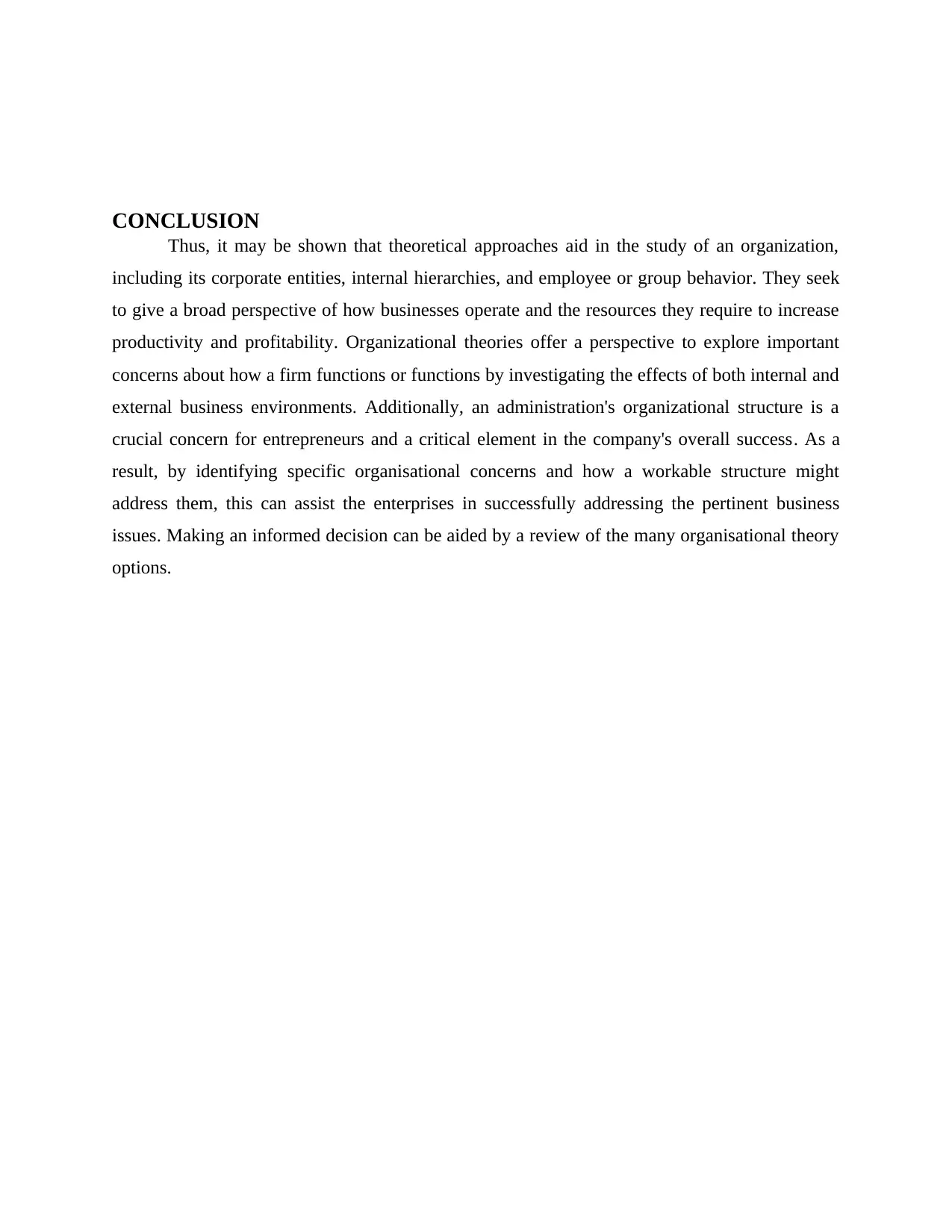
CONCLUSION
Thus, it may be shown that theoretical approaches aid in the study of an organization,
including its corporate entities, internal hierarchies, and employee or group behavior. They seek
to give a broad perspective of how businesses operate and the resources they require to increase
productivity and profitability. Organizational theories offer a perspective to explore important
concerns about how a firm functions or functions by investigating the effects of both internal and
external business environments. Additionally, an administration's organizational structure is a
crucial concern for entrepreneurs and a critical element in the company's overall success. As a
result, by identifying specific organisational concerns and how a workable structure might
address them, this can assist the enterprises in successfully addressing the pertinent business
issues. Making an informed decision can be aided by a review of the many organisational theory
options.
Thus, it may be shown that theoretical approaches aid in the study of an organization,
including its corporate entities, internal hierarchies, and employee or group behavior. They seek
to give a broad perspective of how businesses operate and the resources they require to increase
productivity and profitability. Organizational theories offer a perspective to explore important
concerns about how a firm functions or functions by investigating the effects of both internal and
external business environments. Additionally, an administration's organizational structure is a
crucial concern for entrepreneurs and a critical element in the company's overall success. As a
result, by identifying specific organisational concerns and how a workable structure might
address them, this can assist the enterprises in successfully addressing the pertinent business
issues. Making an informed decision can be aided by a review of the many organisational theory
options.
Paraphrase This Document
Need a fresh take? Get an instant paraphrase of this document with our AI Paraphraser
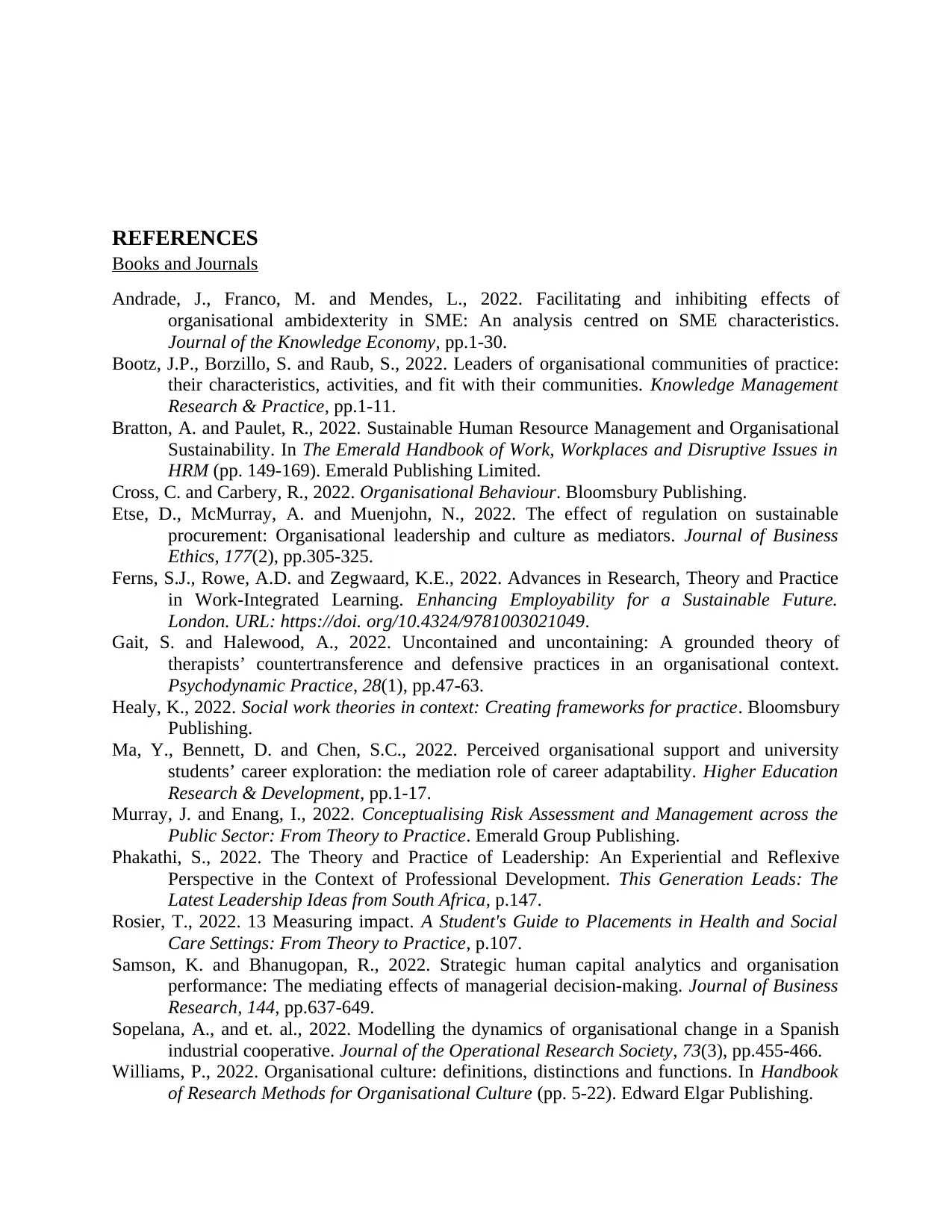
REFERENCES
Books and Journals
Andrade, J., Franco, M. and Mendes, L., 2022. Facilitating and inhibiting effects of
organisational ambidexterity in SME: An analysis centred on SME characteristics.
Journal of the Knowledge Economy, pp.1-30.
Bootz, J.P., Borzillo, S. and Raub, S., 2022. Leaders of organisational communities of practice:
their characteristics, activities, and fit with their communities. Knowledge Management
Research & Practice, pp.1-11.
Bratton, A. and Paulet, R., 2022. Sustainable Human Resource Management and Organisational
Sustainability. In The Emerald Handbook of Work, Workplaces and Disruptive Issues in
HRM (pp. 149-169). Emerald Publishing Limited.
Cross, C. and Carbery, R., 2022. Organisational Behaviour. Bloomsbury Publishing.
Etse, D., McMurray, A. and Muenjohn, N., 2022. The effect of regulation on sustainable
procurement: Organisational leadership and culture as mediators. Journal of Business
Ethics, 177(2), pp.305-325.
Ferns, S.J., Rowe, A.D. and Zegwaard, K.E., 2022. Advances in Research, Theory and Practice
in Work-Integrated Learning. Enhancing Employability for a Sustainable Future.
London. URL: https://doi. org/10.4324/9781003021049.
Gait, S. and Halewood, A., 2022. Uncontained and uncontaining: A grounded theory of
therapists’ countertransference and defensive practices in an organisational context.
Psychodynamic Practice, 28(1), pp.47-63.
Healy, K., 2022. Social work theories in context: Creating frameworks for practice. Bloomsbury
Publishing.
Ma, Y., Bennett, D. and Chen, S.C., 2022. Perceived organisational support and university
students’ career exploration: the mediation role of career adaptability. Higher Education
Research & Development, pp.1-17.
Murray, J. and Enang, I., 2022. Conceptualising Risk Assessment and Management across the
Public Sector: From Theory to Practice. Emerald Group Publishing.
Phakathi, S., 2022. The Theory and Practice of Leadership: An Experiential and Reflexive
Perspective in the Context of Professional Development. This Generation Leads: The
Latest Leadership Ideas from South Africa, p.147.
Rosier, T., 2022. 13 Measuring impact. A Student's Guide to Placements in Health and Social
Care Settings: From Theory to Practice, p.107.
Samson, K. and Bhanugopan, R., 2022. Strategic human capital analytics and organisation
performance: The mediating effects of managerial decision-making. Journal of Business
Research, 144, pp.637-649.
Sopelana, A., and et. al., 2022. Modelling the dynamics of organisational change in a Spanish
industrial cooperative. Journal of the Operational Research Society, 73(3), pp.455-466.
Williams, P., 2022. Organisational culture: definitions, distinctions and functions. In Handbook
of Research Methods for Organisational Culture (pp. 5-22). Edward Elgar Publishing.
Books and Journals
Andrade, J., Franco, M. and Mendes, L., 2022. Facilitating and inhibiting effects of
organisational ambidexterity in SME: An analysis centred on SME characteristics.
Journal of the Knowledge Economy, pp.1-30.
Bootz, J.P., Borzillo, S. and Raub, S., 2022. Leaders of organisational communities of practice:
their characteristics, activities, and fit with their communities. Knowledge Management
Research & Practice, pp.1-11.
Bratton, A. and Paulet, R., 2022. Sustainable Human Resource Management and Organisational
Sustainability. In The Emerald Handbook of Work, Workplaces and Disruptive Issues in
HRM (pp. 149-169). Emerald Publishing Limited.
Cross, C. and Carbery, R., 2022. Organisational Behaviour. Bloomsbury Publishing.
Etse, D., McMurray, A. and Muenjohn, N., 2022. The effect of regulation on sustainable
procurement: Organisational leadership and culture as mediators. Journal of Business
Ethics, 177(2), pp.305-325.
Ferns, S.J., Rowe, A.D. and Zegwaard, K.E., 2022. Advances in Research, Theory and Practice
in Work-Integrated Learning. Enhancing Employability for a Sustainable Future.
London. URL: https://doi. org/10.4324/9781003021049.
Gait, S. and Halewood, A., 2022. Uncontained and uncontaining: A grounded theory of
therapists’ countertransference and defensive practices in an organisational context.
Psychodynamic Practice, 28(1), pp.47-63.
Healy, K., 2022. Social work theories in context: Creating frameworks for practice. Bloomsbury
Publishing.
Ma, Y., Bennett, D. and Chen, S.C., 2022. Perceived organisational support and university
students’ career exploration: the mediation role of career adaptability. Higher Education
Research & Development, pp.1-17.
Murray, J. and Enang, I., 2022. Conceptualising Risk Assessment and Management across the
Public Sector: From Theory to Practice. Emerald Group Publishing.
Phakathi, S., 2022. The Theory and Practice of Leadership: An Experiential and Reflexive
Perspective in the Context of Professional Development. This Generation Leads: The
Latest Leadership Ideas from South Africa, p.147.
Rosier, T., 2022. 13 Measuring impact. A Student's Guide to Placements in Health and Social
Care Settings: From Theory to Practice, p.107.
Samson, K. and Bhanugopan, R., 2022. Strategic human capital analytics and organisation
performance: The mediating effects of managerial decision-making. Journal of Business
Research, 144, pp.637-649.
Sopelana, A., and et. al., 2022. Modelling the dynamics of organisational change in a Spanish
industrial cooperative. Journal of the Operational Research Society, 73(3), pp.455-466.
Williams, P., 2022. Organisational culture: definitions, distinctions and functions. In Handbook
of Research Methods for Organisational Culture (pp. 5-22). Edward Elgar Publishing.

⊘ This is a preview!⊘
Do you want full access?
Subscribe today to unlock all pages.

Trusted by 1+ million students worldwide
1 out of 12
Related Documents
Your All-in-One AI-Powered Toolkit for Academic Success.
+13062052269
info@desklib.com
Available 24*7 on WhatsApp / Email
![[object Object]](/_next/static/media/star-bottom.7253800d.svg)
Unlock your academic potential
Copyright © 2020–2025 A2Z Services. All Rights Reserved. Developed and managed by ZUCOL.




